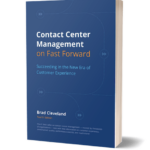Any part of the organization that interacts directly with customers has the potential to create value on three distinct levels: efficiency, customer satisfaction and strategic value. Level three leverages customer intelligence to deliver strategic value to the organization. This excerpt from Contact Center Management on Fast Forward outlines key lessons to maximize this potential. It focuses on contact centers, but applies to other business areas as well.
 As a primary customer touchpoint, the contact center has enormous potential to provide other business units with valuable intelligence and support. This can include input on customers, products, services and processes. When this information is captured, identified, assimilated and turned into usable knowledge, it can literally transform an organization’s ability to identify and meet customer expectations.
As a primary customer touchpoint, the contact center has enormous potential to provide other business units with valuable intelligence and support. This can include input on customers, products, services and processes. When this information is captured, identified, assimilated and turned into usable knowledge, it can literally transform an organization’s ability to identify and meet customer expectations.
How do you identify and leverage the potential your contact center has? A number of key lessons have emerged:
- Seek first to understand. Develop good working relationships with the individuals who run other areas of the organization. Learn about their goals and objectives and how the contact center might best support their needs.
- Build an understanding of the contact center’s role and potential. Ensure that the prevailing perspective is that the role of the center is to serve other parts of the organization, not to point out flaws.
- Build a team that is focused on capturing, analyzing, sharing and using value-added information across the organization. A suggested ratio is that you need one business analyst for every 30 to 50 agents. The ideal ratio depends on many factors, but will become clearer once you get started.
- Ensure that quality at the point of customer contact is given the broadest possible definition—e.g., that coaching, quality observation and objectives at the agent level are all considered essential elements of these major strategic opportunities.
- Define assumptions and unknowns in reports and data. Ensure that everyone understands where the data comes from and what definitions are in place. Strategic decisions based on misinterpreted reports can be worse than if there were no reports at all.
- Get the best tools you can. Analytics and performance management systems can help you analyze content, detect trends and causal factors, and identify improvement opportunities. Get started even if you don’t have these capabilities, but work toward acquiring and building supporting technologies.
- Don’t get overwhelmed. There is a ton of information that you could provide to each business unit. Instead of focusing on quantity (by trying to ensure that everything that may be valuable is shared), concentrate on providing the information that is likely to be most useful.
Every interaction your center handles provides insight into processes, products, policies, services, customers and the external environment. You have the opportunity to play a central role in building a stronger organization with better services and products across the board. But it’s a role that must be earned.
Excerpt from Contact Center Management on Fast Forward by Brad Cleveland.